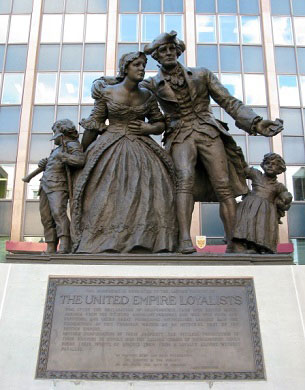Forced from their homes and persecuted at the end of the American Revolution, United Empire Loyalists sought refuge in British Canada. When war broke out in 1812, Loyalist families committed themselves to defending the British Crown and their lands for a second time.
“There remained only smoldering ruins” daughter of a loyalist reflecting on the burning of her family’s settlement by American forces

Safforest via Wikimedia Commons
In the years following their victory in the War of Independence, American patriots drove nearly 60,000 loyal British subjects from their homes in the thirteen colonies. Many loyalists sought refuge in the British colony of Canada to the north. In their own minds, those Loyalists had fought simply to defend the Crown and protect their homes. In the wake of the British defeat, however, they were vilified and branded as traitors by their former neighbors.
Most Loyalists settled in the eastern regions of Nova Scotia and New Brunswick. Others settled in Lower Canada (present-day Quebec) or Upper Canada (present-day Ontario). Even with land grants and food from government stores, these Loyalists struggled to rebuild their lives on the Canadian frontier.
Each Loyalist family had its own story of struggle and dispossession. At the outbreak of the War of Independence, Samuel Ryerse had no difficulty declaring his loyalty to the British crown. He raised a company of sixty loyal subjects and became a captain in the British Army. But when the war ended in British defeat, Ryerse left America for New Brunswick, where he received a land grant from the Crown.
Finding his new land unsuitable for farming, Ryerse moved again, settling on the banks of Lake Erie in 1794. He found that land more amenable to raising crops. “My father in seventeen years had seen a lonely wilderness changed into a fruitful country,” wrote Amelia Ryerse, Samuel’s daughter.
After fighting and escaping from the American Patriots in his early years and rebuilding a life on the shores of Lake Erie, Samuel died only weeks before Congress declared war on Britain in 1812. But war was not finished with the Ryerse family.
Two years into the fighting, American forces captured the Ryerse settlement. Amelia later described the destruction visited upon her family’s farm: “Very soon we saw columns of dark smoke arise from every building, and of what at early morn had been a prosperous homestead, at noon there remained only a smoldering ruins.” Like many Loyalists, Samuel Ryerse had been cast out of the United States, had relocated to Canada and rebuilt his family—only for them to lose everything again after war broke out 1812.
Nevertheless, the Americans’ failure to conquer Canada evoked a powerful sense of vindication for many Loyalists who managed to survive both conflicts. Those survivors came to form their own brand of postwar identity—one based on resistance, unity, and loyalty to empire.
Last updated: March 5, 2015
